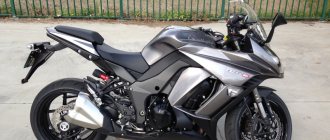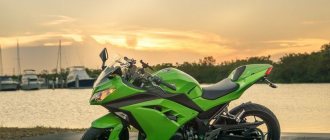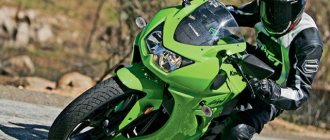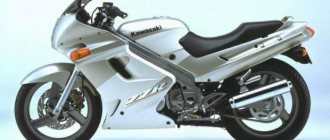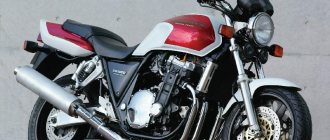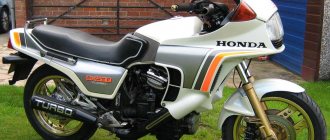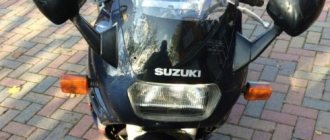Not long ago, one of the leaders in the motorcycle industry, Kawasaki, literally fired a salvo from its entire arsenal at the Cologne Intermot, presenting several new products at once, each of which was both interesting and useful. An important feature is that many companies demonstrate exclusive models that are not aimed at the general population. Unlike its competitors, the Kawasaki company produces truly popular motorcycles, which are both affordable in price and in terms of technical characteristics are not inferior to (and in some cases superior to) their analogues. “Kawasaki Ninja 1000” is one of the most prominent representatives of the Kawasaki model range.
Motorcycle is not for everyone
Contrary to the above about the company producing people's motorcycles, the Kawasaki Ninja 1000 is not for everyone. Up to 160 km/h it is useless to look at the speedometer - the needle rises so rapidly that it is impossible to follow it. Plus 13 horsepower to the herd that was before the model update, the bike accelerates in just a few moments. 210 kilometers per hour - and this is only in second gear.
“Kawasaki Ninja 1000” is the very first “liter” from the entire “green” stable. The bike was first released in 2009 as a replacement for the Kawasaki Ninja ZX9R. Essentially, this is the result of a headlong race towards perfection. What can you say about this bike? First of all, the only thing is that this motorcycle is intended for those who sit confidently in the saddle, do not pull the throttle at the first rein, but tightly control the behavior of their horse on the road.
2011 – Kawasaki Ninja 1000 vs. Suzuki GSX1250FA and Yamaha FZ1
Posted on August 7th, 2011 by admin
Three of the best sportbikes you can ride without cramped legs or sore wrists.
What started out as a simple duel between the Kawasaki Ninja 1000 and the 2011 Yamaha FZ1 turned into a truly exciting showdown when the 2011 Suzuki GSX1250FA entered the fray. Newcomer Suzuki pushed the boundaries of the first two bikes' judging criteria, helping to highlight the flaws and shortcomings that balanced them out. advantages.
Introduced this year, the Kawasaki Ninja 1000 and Suzuki GSX1250FA are the latest models in the trio. The updated Suzuki Bandit now features a full fairing and ABS as standard, which is more typical for the sport-touring class than for a sportbike.
The Ninja has more sporty features and a powerful four-cylinder Z1000 engine, which, however, does not guarantee absolute superiority over other rivals. Each of our test riders had their own opinion on why the motorcycle they liked should take the top spot. The renamed Bandit Suzuki GSX and the rather old (since 2006) Yamaha FZ1 have an advantage in some details over the Ninja, whose developers probably forgot to implement something that every liter sportbike simply must have.
Where exactly the Ninja Z1000 has the upper hand over the Yamaha is the engine, which is even more powerful. The Kawasaki six-speed had me on the Yamaha counting the seconds until the four-cylinder FZ1 revs. At some point the R1 engine finally reached the peak of its power and acceleration was impressive, but by this time the Z1000 was already a long way off. The FZ1 itself is very fast, but compared to the new Ninja, it feels a little sluggish until it accelerates, of course.
“A motorcycle engine is a key aspect of fast, dynamic riding and in this regard the Ninja engine is as good as ever,” said one rider named Duke. It easily outperforms the Yamaha at low revs, and its short gears have always been a standout feature. Kawi will win any race, I'm sure."
The GSX1250FA, with its 98 Nm of torque at 3500 rpm, wins over the Ninja, which has 97 Nm at 7800 rpm. But the Suzuki's curb weight is 257.2kg, making it almost 29kg heavier than the Kawasaki (228kg) and 36.3kg heavier than the FZ1 (220.9kg). With a torque band that starts at 92.1Nm at 2700rpm and rises all the way to 6800rpm, the GSX is undoubtedly the leader in this area among our three bikes. But where the Suzuki clearly falls short is horsepower output: 92.6 hp at 8,800 rpm, while the Ninja's 121.1 hp at 10,100 rpm and the FZ's 125.1 hp at 11300 rpm.
To say that Kawasaki has a great engine is an understatement. The new Ninja 1000 has the perfect combination of sportbike performance that allows it to be used in urban environments. According to leading sports publications: “The Ninja 1000 has the most outstanding sportbike look possible. Kawasaki has developed and produced a powerful engine that can be used in the city every day. This bike has the most low- and mid-range torque of any sportbike we've ridden."
Considering the Suzuki's 1255cc engine capacity (79.0 x 64.0mm bore and stroke), horsepower numbers below 100 are somewhat disappointing, but well masked by phenomenal low-end torque.
The Ninja and FZ1 share the same 77.0mm piston bore, but the Kawi's engine is slightly larger (1043 vs. 998cc) and also has a higher compression ratio (11.8:1 vs. 11.5:1). In combination with different camshaft profiles, this explains the difference in power characteristics. If you prefer a more track-oriented sportbike, the FZ1 is your choice, but for more casual riding, the Ninja or GSX is preferable.
In terms of riding position and distance from the seat to the pegs, it's hard to tell the difference - all three bikes can confidently score gold stars in the comfort department. But for long and long trips, we would still choose Suzuki.
“The Suzuki 1250FA is a great sport tourer,” notes Boomer. This is the most comfortable motorcycle in the test, and I would say, in general, of motorcycles of this type. What’s also great is that the bike handles bumps and bumps on the road very well.”
Ergonomics and controls
Suzuki and Yamaha lose out to Kawasaki in gas tank design. The Ninja's tank is flat and comfortable, conveying a sense of control over the bike, while the FZ1's tank is large, and the GSX's has an awkward protrusion where it mounts to the frame.
“In terms of comfort, the difference between the Kawasaki Ninja Z1000 and the FZ1 is not very noticeable,” notes tester Kevin. The Yamaha's seat feels a little firmer, the handlebar position on both is very motocross-like, and the vibration damping seems fairly acceptable on both the Ninja and FZ1."
Additional comfort on the Kawasaki is provided by a windshield that has three manual adjustment positions. In the lower position, the best aerodynamic characteristics are achieved, while increasing the force of the wind flow on the driver, which is no less important on hot and stuffy days. The high position accordingly reduces exposure to cold air. My height is 180 cm, and with the glass in the lower position I felt the impact of incoming air currents on my chest, and with the glass in the upper position - in the area of the collarbones, and surprisingly - no effects of turbulence!
The Yamaha windshield is certainly functional, but here the wind flow is controlled by the rise and fall of your body. In terms of wind protection, the Fizzer's functionality is quite modest, falling between its class and being a naked streetfighter. But full wind protection gave a new look to the Suzuki Bandit model, the body of which, although it reliably sheltered the lower part of the body from the wind, was unlikely to receive any award for style.
Yamaha and Suzuki are equipped with a centerstand, which will appeal to motorcyclists who like to maintain their machines themselves, while Kawasaki lacks this, which may be due to the desire to reduce weight (Yamaha weighs about 221 kg, Kawasaki 228.1 kg), or maybe due to ground clearance In any case, a motorcycle equipped with a centerstand can easily be maintained by one person, which would be quite difficult to do without it.
Additionally, the FZ1 has fairly easy access to the engine, while the Ninja and GSX have most of the body kit's plastic parts that must be removed for even the most basic servicing. But the presence of these same body kit parts in the Ninja and GSX provides quite significant protection for the rider in rainy and cold weather. Of course, those who love open-engined motorcycles will prefer the shape and lines of the FZ1 over the plastic-laden Suzuki. But the most aggressive look of all three is Ninja.
In terms of handling, all three bikes performed well despite their weight, and cornering performance was fairly neutral. Considering the amount of fuel (about 19 liters or 13.6 kg) placed at the top of the frame, I personally expected them to be much heavier to handle. But of all three, the GSX still seemed a little heavier to some testers.
“The FA is a little longer and heavier than the rest of the bikes,” says Giardinelli, “it won’t turn as fast as other bikes, but it has a stable underpinnings that Suzuki have done a good job with.”
The Ninja has excellent steering response and excellent directional control, but we did notice a small flaw: when cornering, you need to turn the steering wheel a little to maintain the desired turning arc. This was especially noticeable after 4,000 km of our rather severe testing, and replacing the base Bridgestone BT-016s tires only slightly corrected the situation.
The FZ1 was hailed as the sportiest, but almost everyone was annoyed by its overly responsive throttle response. Yamaha has updated the ECU several times and it works much better than before, but some issues still remain. “The neat, smooth, controlled fuel management of the Yamaha's ECU makes it a challenge to tackle difficult sections of the trail,” Giardinelli observes.
At first glance, neither bike seemed to have a braking advantage, but the FZ1 has dual 320mm discs and four-piston calipers up front, which still provide slightly better stopping feel than the 300mm calipers. Kawasaki's dual front disc brakes with four-piston radial-mount calipers. Considering that the Suzuki weighs more than the rest, its brakes coped with their task no worse than its rivals, and it is worth noting that this is the only motorcycle of the comparison equipped with ABS.
Unlike the FZ1, the Ninja's 41mm inverted forks are pre-set to sport mode, although both bikes have fully adjustable forks, allowing anyone to tweak them to suit their preferences. At the rear, both the FZ1 and Ninja feature a preload- and rebound-adjustable shock absorber.
The GSX's weight sometimes punches through its suspension, but the preload-adjustable 43mm fork and rear shock (which has preload and rebound adjustment) are still up to the task in moderately aggressive conditions.
“I expected the 1250 to live up to its price tag, but it's definitely not at the top of the podium,” Smith notes of the Suzuki. On the way home I felt that the suspension was not as good as I thought."
In addition to the aforementioned ABS and centerstand, the GSX is equipped with a gear position indicator, an adjustable clutch lever (all three bikes have an adjustable front brake lever) and a helmet mount. The FZ has a centerstand and side rails, but no helmet mount, while the Ninja Z1000 only has side rails.
“The Kawasaki Ninja is a great bike, it seems to have everything in place for the rider's comfort, so the lack of a helmet mount or at least hooks is a glaring omission, as it is great for both casual commuting and sports touring.” , notes the picky Duke.
The most comfortable passenger seating was found on the Suzuki. Its seat is quite low and has the best combination of comfort and support, providing neutral-upright ergonomics. The Kawasaki has a slightly leaner stance and is more comfortable to hold onto the handles during, for example, aggressive braking.
For those who love to travel and need luggage, Suzuki offers optional hard saddlebags and a 37-liter overhead storage bin. Yamaha offers top drawers with different volumes - 40, 45 and 50 liters. The Kawasaki can be equipped with 35 liter lockable hard bags.
Prices and Summary
The prices of these three sportbikes are quite an interesting aspect. The GSX1250FA is equipped with ABS, but the $11,599 asking price still seems a bit steep for a bike that lacks any high-tech features and differs from its predecessor models only in appearance. The FZ1 has the lowest price of the three at $10,490, but its engine is atrocious.
The Ninja Z1000 sits in the middle with its $10,999 price tag, and after carefully weighing the pros and cons of each bike compared, I would choose it for its distinct balance of sporty aggression and touring comfort.
However, there are other opinions on this matter, let's see what Smith and Giardinelli have to say.
“I liked the Yamaha FZ1 the most,” said Giardinelli. Its engine isn't as buzzy as the Ninja 1000's and it's more nimble than the big Suzuki 1250FA. In general, it is comfortable, has decent wind protection, and the power is also at the level (except for low revs). Of course, it will not be the favorite in its category for a number of reasons, but many things in it are done at a high level.”
As for Smith, he would have chosen the Ninja if he didn't already have a Gixxer 1000 in his garage. He also thinks the GSX1250FA is a decent bike.
“I completely understand the appeal of motorcycles like the FZ1 or Ninja,” says the former motorcycle magazine editor. The latter, by the way, really corresponds to the concept of a modern sportbike designed for city riding. But so far they don’t quite suit my preferences (and my wallet too). Of the three, only the Suzuki can make me want to drop everything and go somewhere else.”
“This bike can easily go coast-to-coast or border-to-border, and it feels like a motorcycle in the corners,” continues Smith. I could call it a “sportbike for every day.”
Giardinelli didn't pick the GSX as his favorite, giving that spot to the Ninja, but he has an idea of who the bike would be a great fit for. “If you like the comfort of a Honda ST1300 or BMW RT, but don't need sporty performance, this is the bike for you.”
Duke also opted for a Kawasaki Ninja Z1000, and while it's not exactly perfect, its comfortable sportiness makes it a good choice for a sportbike enthusiast.
“I bet you anything, but this bike is the fastest liter sportbike,” says Duke. Its engine rumble and transmission ratios are more than suited for street driving, and its relatively upright driving position is best suited for rough roads.”
Popular opinion
It is unlikely that any of the owners of the fast and powerful Kawasaki Ninja 1000, when describing their horse, will use epithets such as “calm”, “balanced”, “flexible” and “quiet”. Most likely, it will be just an explosion of emotions using expressive language and a few exclamation marks.
Someone put it very well about the 2004 model: “This motorcycle is simply created for crazy people. “Kawasaki Ninja 1000” doesn’t give anyone a warning slap in the face – it hits clearly and immediately.”
Nevertheless, in just a few years, the ZX-10R has become an incredibly popular model, which has been adopted by both experienced and completely “green” bikers. Dynamic design in a futuristic style, streamlined body and decent technical characteristics - all these are prerequisites for the popularization of this model.
Tuning Kawasaki Ninja 300
Read other motorcycle reviews Stels Benelli 600 motorcycle review
An example of tuning a Kawasaki Ninja 300. Photo.
Tuning is the improvement of a motorcycle by installing additional devices and components. The process is entirely individual, as each driver tries to add features that are necessary for him personally. A city biker will try to impress with chrome accessories, a tourism enthusiast will take care of improving the optics and windshield. Some people are missing a clock on the dashboard, while others are trying to improve the chassis.
The rapid growth in the popularity of tuning around the world has determined the offer of well-known companies for entire motorcycle modernization kits. Among the Americans you can Fr. She released a tuning kit for the Kawasaki Ninja250 model. The Kawasaki manufacturer began producing original tuning and accessories for its models. Factory Kawasaki parts and tuning will make your motorcycle more comfortable, stylish and faster.
Power and top speed of the Kawasaki Ninja 1000
The 998 cm3 four-cylinder engine generates 175 hp. s., which is achieved at 11,700 rpm. The numbers look very nice, especially considering that the weight of the motorcycle is not very large - only 170 kg. But that's not what's shocking. What's amazing is how the Kawasaki Ninja ZX-10R delivers this power.
In order to really imagine this, it is enough to imagine the following: a presentable restaurant, a client orders partridge stewed in a noble manner and a bottle of exquisite wine from the waiter. Garcon, instead of serving the dish on a golden tray decorated with lush greens and baked apples, throws a partridge in the guest’s face and breaks the bottle on his head. The ZX-10R develops its power approximately this way.
In 2006, an updated model was introduced, which became softer and more flexible. Although, probably, in this case, the new thing looked like a mad tiger after a week-long hunger strike, feasting on yogurt. “Kava” remained just as sharp and piercing. But at the same time, other indicators have improved - the stability of the motorcycle at high speed and second-rate roads has increased. In addition, an Ohlins steering damper has appeared, which is very good for owners. After all, it used to be the very first thing on the list of necessary purchases.
The developers claim that the Kawasaki Ninja 1000 motorcycle is very friendly. Can this statement be true if the ZX-10R is in Power Wheelie position in third gear at mid-range RPM? Let it remain on their conscience.
Striving for the best
Experienced pilots still noticed improvements for the better. And all because the developers did not increase the engine power, but took a different path - they began to “train” the unbridled power of the Kava. The explosive nature of the engine of the first model significantly complicated the piloting process, which was especially felt when turning. The rear wheel could easily come off with a sudden release of gas. Even the slipper clutch, which was installed as standard, did not really help the situation. A review of the 2009 Kawasaki Ninja 1000 allows you to see all the innovations with your own eyes.
In this case, only a heavier flywheel, crankshaft and an improved injection system could correct the situation. As a result, the torque value in the mid-speed zone has increased. Power and torque began to increase gradually, without sudden bursts or hysterics. So the pilot was able to calmly twist the throttle while turning, without fear of the rear wheel falling off. By the way, the heavy flywheel made engine braking easier.
Model overview
The engineers have worked hard to put together a motorcycle that combines power and agility perfectly.
Thanks to the 600cc engine, this bike reaches a maximum speed of 280 km/h, but its low weight makes it agile on the most difficult turns.
Now a few laps on this bike have become an exciting ride at incredible speed.
In addition to ideal weight and excellent speed, the Kawasaki Ninja 600 received its main parameters from the Ninja ZX-6RR, which had previously been released in limited quantities.
So, let's get started with a detailed review of this racing car.
- Frame. Most likely, even on the drawings, the engineers had an idea to create a frame with maximum harmony between a rigid landing and flexible control.
Thanks to this design, at the beginning of a turn, synchronization with the steering wheel is absolutely maximum.
To create such a balance, it was necessary to calculate the location of the pendulum and the position of the motor.
The Kawasaki Ninja 600 ZX 6R has a frame made of a single unit, thanks to which the motor moves simultaneously with the frame. This design allows you to move all the weight evenly, gaining greater speed.
- Engine. The main aspect of the engine is the slipper clutch. When making a sharp jerk on a turn, the pilot will not need to fear falling.
- Suspension. In a motorcycle, the suspension can be adjusted depending on the type of road on which the bike will be ridden.
- The brakes are powerful.
- The landing is sporty.
Suspension and braking system
The 2006 model features an improved suspension, thanks to which the bike confidently plows not only smooth trails, but also second-rate roads with holes, humps and potholes. The previous version could cause serious fear in such conditions (as if the engine had not done this before!).
Front 4-piston calipers, which literally bite into two discs with a diameter of 300 mm, are more effective, although they require the use of considerable force. The rear brake responds more readily to the pilot's wishes. Of course, at that time, installing reinforced brake hoses is the optimal solution for this model. The updated model has acquired a pointed tail, under which a dual exhaust is successfully hidden. This, by the way, had little effect on the turbulence of the model.
Relatively small lens headlights with a “tear-shaped” shape and a powerful air intake capable of sucking in a crow appealed to all those who considered the first model too simple and characterless. An attractive highlight is the LED rear brake light and turn indicators.
Brief history of the model
Model
: Kawasaki Z1000 (all regions).
Factory designation
: ZR1000-A1.
2004 - no significant changes.
Model
: Kawasaki Z1000 (all regions).
Factory designation
: ZR1000-A2.
2005 - the model receives an immobilizer system.
Model
: Kawasaki Z1000 (all regions).
Factory designation
: ZR1000-A3.
2006 - no significant changes.
Model
: Kawasaki Z1000 (all regions).
Factory designation
: ZR1000-A6F.
2007 - restyling of the model. Second generation. The model receives an updated appearance, radial calipers at the front, different rear suspension settings and a reduction in fuel tank capacity from 19.0 → 18.5 liters. Maximum power decreases: 127 → 125 hp.
Model
: Kawasaki Z1000 + ABS (all regions).
Factory designation
: ZR1000-B7F + ZR1000-C7F.
2008 - no significant changes.
Model
: Kawasaki Z1000 + ABS (all regions).
Factory designation
: ZR1000-B8F + ZR1000-C8F.
2009 - no significant changes.
Model
: Kawasaki Z1000 + ABS (all regions).
Factory designation
: ZR1000-B9F + ZR1000-C9F.
2010 - restyling of the model. Third generation. The model receives a new external, aluminum frame, a larger engine (953 → 1043 cm³), fully adjustable front forks, monoblock front calipers and a reduced fuel tank capacity (18.5 → 15.0 l). Maximum power increases: 125 → 138 hp.
Model
: Kawasaki Z1000 + ABS (all regions).
Factory designation
: ZR1000-DAF + ZR1000-EAF.
2011 - appearance of the Kawasaki Z1000SX modification (sold in the North American market as the Kawasaki Ninja 1000).
Model
: Kawasaki Z1000 + ABS;
Kawasaki Z1000SX / Ninja 1000 + ABS (all regions). Factory designation
: ZR1000-DBF + ZR1000-EBF; ZX1000GBF + ZX1000HBF.
2012 - no significant changes.
Model
: Kawasaki Z1000 + ABS;
Kawasaki Z1000SX / Ninja 1000 + ABS (all regions). Factory designation
: ZR1000-DCF + ZR1000-ECF; ZX1000GCF + ZX1000HCF.
2013 - no significant changes.
Model
: Kawasaki Z1000 + ABS;
Kawasaki Z1000SX / Ninja 1000 + ABS (all regions). Factory designation
: ZR1000-DDF + ZR1000-EDF; ZX1000GDF + ZX1000HDF.
2014 - restyling of the model. Fourth generation. The model receives an updated appearance, LED optics, a slipper clutch (Assist & Slipper clutch), an increase in the diameter of the front brake discs (300 → 310 mm), an increase in fuel tank capacity (15.0 → 17.0 l) and an increase in maximum power (138 → 142 hp).
Model
: Kawasaki Z1000 + ABS;
Kawasaki Z1000SX / Ninja 1000 + ABS (all regions). Factory designation
: ZR1000-FEF + ZR1000-GEF; ZX1000LEF + ZX1000MEF.
2015 - no significant changes.
Model
: Kawasaki Z1000 + ABS;
Kawasaki Z1000SX / Ninja 1000 + ABS (all regions). Factory designation
: ZR1000-FFF + ZR1000-GFF; ZX1000LFF + ZX1000MFF.
2016 - no significant changes. The Z1000SX / Ninja 1000 version is now offered only in the ABS version.
Model
: Kawasaki Z1000 + ABS;
Kawasaki Z1000SX / Ninja 1000 ABS (all regions). Factory designation
: ZR1000-FGF + ZR1000-GGF; ZX1000MGF.
2017 - restyling of the model. Fifth generation. The appearance is slightly updated, the rear suspension settings are changed. A Performance version appears - Kawasaki Z1000R. Versions without ABS are no longer produced.
Model
: Kawasaki Z1000 ABS;
Kawasaki Z1000SX / Ninja 1000 ABS (all regions). Factory designation
: ZR1000-HHF;
ZX1000WHF.
2018 - no significant changes.
Model
: Kawasaki Z1000 ABS;
Kawasaki Z1000SX / Ninja 1000 ABS (all regions). Factory designation
: ZR1000-HJF; ZX1000WJF.
2019 - no significant changes.
Model
: Kawasaki Z1000 ABS;
Kawasaki Z1000SX / Ninja 1000 ABS (all regions). Factory designation
: ZR1000-HKF; ZX1000WKF.
2020 - no significant changes.
Model
: Kawasaki Z1000 ABS (all regions).
Factory designation
: ZR1000-HLF.
Technical characteristics of the 2008 Kawasaki Ninja 1000
This is exactly what you need. The company introduced the truly friendly Kawasaki ZX-10R in 2008. This model turned out to be so charismatic and unlike its predecessors that at first glance it could not be attributed to the rest of the horses from the Ninja stable. And in terms of behavior on the road, it was a completely different bike.
A chassis with excellent feedback and almost feminine sensitivity, an ergonomic pilot position, special recesses on the tank for elbows, which is very convenient when driving - and this is not a complete list of pleasant surprises.
The updated Kawasaki Ninja 1000, the technical characteristics of which deserve special attention, is a new fork design with springs located at the bottom and completely immersed in oil, the installation of a rear shock absorber that can be adjusted for different speeds.
Exterior design of the sportbike
The Kawasaki Ninja 600 has an impressive appearance with a sporty style.
The first thing that catches your eye in the foreground are the high-brightness dual headlights.
The style is also complemented by the Ram Air air intake system, which is placed in the center of the bike.
Turn signals are built into the front fairing.
The wing at the front has acquired an aerodynamic shape.
At the rear, the turn signals are quite small and cone-shaped. The rear light is equipped with bright LEDs.
It precisely projects the shape of the rear fairing and is located high above the road level, which ensures maximum visibility of the motorbike on the road.
The instrument panel is made in a racing style and consists of:
- Gear adjustment indicator.
- Digital speedometer.
- Diagram tachometer.
- Digital thermometer.
- Stopwatch.
- Watch.
- Indicator lamps.
- Odometer.
In addition, it can be noted that the exhaust system is made of stainless steel. The sporty style is reflected in the passenger footrests.
The mounting panel was made in the form of a triangle with special cutouts. The bike frame has a black finish.
Leaving a Honda Fireblade in the dust
At the races in Qatar, along with the Kawasaki ZX-10R, another superbike, the 2007 Honda Fireblade, was presented. Nevertheless, “Cava” pulled up its opponent, leaving the no less famous Blade behind. This is especially true for the tachometer - as soon as you cross the cherished mark, the green stallion rapidly rushes forward, quickly turning into a point on the horizon.
Much of the credit for this, of course, goes to the engine. But there is one more “but” - this is a special wheel-road traction system, which is called KIMS (Kawasaki Ignition Management System). It’s worth avoiding all the marketing fluff and explaining the principle of operation in simple words. You can immediately note that this is not the wheel-road traction system itself - there are not enough special wheel speed sensors for this. Besides, the motorcycle will still slide. And the rear wheel will carry away when you sharply release the gas when cornering. And you can fly off the road at high speed.
But the unique Kawasaki Ignition Management System, which deserves special attention, helps to avoid all this.
KIMS
The system works as follows: the on-board computer monitors the readings of all sensors directly, combining them into one picture. This happens every 200th of a second. Thanks to the information received, the computer receives information about what is currently happening on the road. In fact, the system predicts the pilot's future behavior.
The work of the on-board computer is aimed at preparing the motorcycle for further changes. If the pilot wants to slide, the motorcycle will do it. What this means is that if you put it in first gear as you exit a tight, tight corner, you can get yourself a ticket to a show where the bike falls on its side and the rider is catapulted straight to the hospital with a broken pelvis.
To prevent this from happening, you need to understand that full throttle is an order for the motorcycle to activate all its power and strength. There is no point in experimenting with the clutch system - this is the prerogative of professional racers, whose fifth point is insured, and for rides there is a special track with an impact fence.
Typical "sores"
When purchasing models from 2003-2004, you should carefully inspect every centimeter of the frame. The very first models often cracked at the seams. Kawasaki ZX-10R 2003-2005 They don’t really like driving in the cold season. Capricious ladies show their character with the help of the brake system - it will have to be changed almost completely if you ride at low temperatures.
The first Kawasaki Ninja models (1000 cc) were distinguished by a weak coating - the varnish managed to peel off along with the sticker or label. Over time, these problems were eliminated. And now the updated models can please you with impeccable engine performance and relatively calm behavior on the roads.
Experienced motorcyclists unanimously say that the current “Kava” is far from the “crumbled” models that were produced in the 90s.
Kawasaki ZX 1000 Ninja H2 price based on sales advertisements
The maximum price of Kawasaki ZX 1000 Ninja H2 among the advertisements found is RUB 900,000*
The average price of Kawasaki ZX 1000 Ninja H2 among the ads found is RUB 452,000*
The minimum price of Kawasaki ZX 1000 Ninja H2 among the advertisements found is RUB 1,000*
Kawasaki Ninja z1000sx in Simferopol
11.21.2020 620,000 rub.
Kawasaki Ninja 1000SX 2021 in Kazan
11/20/2020 1,100 rub.
Kawasaki ninja 1000 in Simferopol
11/20/2020 RUB 360,000
Kawasaki Ninja 1000 2014 in St. Petersburg
11/19/2020 RUB 590,000
Kawasaki Z1000SX (Ninja1000) in Vladivostok
11/18/2020 RUB 570,000
Kawasaki Z1000SX ABS Ninja 1000 2015 in Moscow
11/16/2020 RUB 599,000
2017 Kawasaki Ninja 650F,10000 km in Moscow
11/10/2020 420,000 rub.
Motorcycle Kawasaki Z1000SX Ninja in Ufa
11/10/2020 470,000 rub.
Kawasaki Ninja 1000A in Nizhnevartovsk
09.11.2020 650,000 rub.
Kawasaki ninja1000 SX ABS green 2021 in Orenburg
06.11.2020 1,227 rub.
Kawasaki ninja 1000, z1000sx, 2011 in Blagoveshchensk
04.11.2020 350,000 rub.
Kawasaki ninja z1000sx in Prokopyevsk
10.27.2020 500,000 rub.
Kawasaki ninja 2015 z1000sx in Dyadkovskaya
10.16.2020 800,000 rub.
Kawasaki Ninja 1000 SX in Volgograd
10/16/2020 RUB 850,000
Motorcycle Kawasaki Ninja 1000 SX Green 2021 new in Moscow
10/05/2020 RUB 1,227
Kawasaki Ninja 1000 SX 2021 in St. Petersburg
09.25.2020 1,227 rub.
Kawasaki ninja z1000sx in Moscow
09/20/2020 430,000 rub.
2017 Kawasaki Ninja 650F,10000 km in Rudnya
09/19/2020 410,000 rub.
Kawasaki Ninja 1000 2014 in Yekaterinburg
09/08/2020 499,000 rub.
Kawasaki z 1000 sx (ninja 1000) 2015 in Moscow
09/07/2020 630,000 rub.
Kawasaki ZX 1000 ninja 1000 2011 6667 in Vladivostok
09/07/2020 485,000 rub.
Kawasaki Z1000 SX Ninja z1000sx in Voskresensk
02/08/2020 465,000 rub.
Kawasaki z1000sx ninja in Moscow
02/03/2020 450,000 rub.
Kawasaki Z1000SXA ninja1000A in Moscow
01/29/2020 RUB 525,000
Kawasaki ninja Z1000SX in Simferopol
01/07/2020 480,000 rub.
Kawasaki ninja 1000 abs in Nevyansk
01/07/2020 445,000 rub.
Selling Kawasaki ninja 1000 in Smidovich
07.11.2019 485,000 rub.
Kawasaki z1000sx ninja in Kerch
09/17/2019 RUB 595,000
Kawasaki Ninja 1000 ABS in Krasnodar
08/28/2019 470,000 rub.
Kawasaki ER-6 ninja 2021 mileage 1000 km in Moscow
08/01/2019 RUB 259,999
Kawasaki z1000sx / ninja1000a in St. Petersburg
07/29/2019 RUB 710,000
Kawasaki z1000sx ninja in Saratov
07/11/2019 430,000 rub.
Kawasaki Ninja1000 ABS. No mileage. Available in Vladivostok
07/06/2019 478,000 rub.
Kawasaki ZX 10R Ninja Krt Edition, 1000/2016 in Rudnya
06/23/2019 870,000 rub.
Kawasaki Ninja 1000 in Krasnodar
06/22/2019 470,000 rub.
Kawasaki GPZ1000rx ninja in Yaroslavl
06/09/2019 75,000 rub.
Kawasaki Ninja Z1000 ABS 2021 new in Izhevsk
06/07/2019 830,000 rub.
Kawasaki ninja 1000 2012 in Vladivostok
06/03/2019 400,000 rub.
Kawasaki ninja z1000sx, 2011 in Nevyansk
05/31/2019 480,000 rub.
Kawasaki ZX 10R Ninja Krt Edition, 1000/2016 in Rudnya
05/20/2019 900,000 rub.
Motorcycle Kawasaki z1000sx ninja z1000 in Voskresensk
05/18/2019 RUB 515,000
Kawasaki z1000sx z1000 z1000-sx z 1000 sx ninja100 in Voskresensk
10/31/2017 RUB 499,000
Kawasaki z1000sx ninja1000 z1000 Kawasaki z 1000sx in Kolomna
06/13/2017 545,000 rub.
Kawasaki ZX1000G ninja 11g in Slavyansk-on-Kuban
06/12/2017 RUB 395,000
Kawasaki ninja gpz1000rx 1995 in Essentuki
03/26/2017 75,000 rub.
Kawasaki ninja 1000 in Slavyansk-on-Kuban
02/20/2017 350,000 rub.
Kawasaki Ninja 2015 Engine Size 1000 in Moscow
03.11.2016 200,000 rub.
Kawasaki z1000 z1000sx ninja1000 Kawasaki 2013 in Yegoryevsk
10/20/2016 RUB 565,000
Kawasaki Ninja zx10r, 1000 in Moscow
08/20/2014 260,000 rub.
Kawasaki ninja ZX9R 1000cc in Chelyabinsk
08/20/2014 150,000 rub.
Kawasaki Ninja Z 1000 in Krasnoyarsk
08/11/2014 450,000 rub.
* Attention! Under the maximum, average and minimum of the Kawasaki ZX 1000 Ninja H2 motorcycle on this page, the average cost according to advertisements for sale on the Internet is indicated, without taking into account the year of manufacture, configuration and generation of the motorcycle model.
Motorcycle Mean Green
The photo “Kawasaki Ninja 1000” is eloquent proof of how good a design idea can be. A predatory look and an aggressive outline are enough to imagine what is going on in the very heart of the bike.
And there is an incredibly powerful engine, which in the first model was simply wild, in the second it became more flexible, and in further modifications - an obedient, but still “damn powerful” engine.
The Kawasaki Ninja ZX10R is quite suitable for daily use. True, it begins to act up when driving too often on second-rate roads.
How much does a liter cost these days?
Models from 2004-2005 in very good condition can be purchased for 6-7 thousand dollars. Horses a little younger will cost the future owner about $10,000. Naturally, a six-year-old Kawasaki Ninja ZX-10R will cost at least 14 thousand conventional units.
The price depends on the condition of the motorcycle and its mileage. A potential racer should understand that buying a ZX-10R to go to the grocery store is like buying a 50cc scooter to travel around the world. Before you buy a suspiciously cheap bike, you should inspect it for a hidden video camera that films a funny story about a naive motorcyclist.
Here's everything you need to know about the powerful, wild and aggressive Ninja Kawasaki. We can only hope that each released model will find its owner with a head and an insured butt.
Description Kawasaki Ninja 1000 ABS 2012
Description of the Kawasaki Ninja 1000 ABS 2012 motorcycle is in the queue for publication of the article. Announcement: Today, for almost every new motorcycle that comes into being, marketers strive to carve out their own niche. This one is a road sport, this one is a recreational enduro. But what class should we include a motorcycle that has a little bit of everything? A good bike should have a reliable engine, comfortable ergonomics and simple controls...
Kawasaki Ninja 1000 ABS is a very rare motorcycle in Russia. Despite the fact that good models of motorcycles have a very respectable price, and the season for their use is relatively short, the motorcycle market is developing rapidly. And if you believe the words of dealers, then some models of recently released motorcycles are selling like hot cakes at the beginning of the season, and the models brought to Russia are clearly not enough to fully satisfy consumer demand.
A motorcycle has long ceased to be an alternative to a car, and the times when this equipment was bought only because there was not enough money for a full-fledged car are forgotten. Nowadays, two-wheelers can be called technological marvels in many cases, and their cost can be compared with that of prestigious cars.
Many people have started buying motorcycles for hobby purposes as riding or even collecting them has become a good pastime for many people. Many motorcycles, for example the Kawasaki Ninja 1000 ABS, whose technical characteristics make it possible to call the model a prestigious brand, are in demand among both beginners and experienced motorcyclists.
